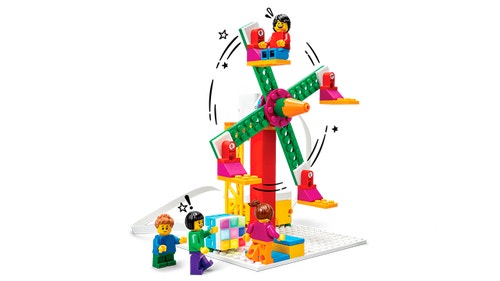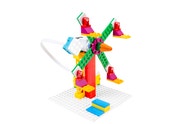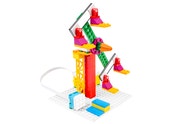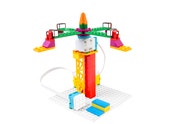SPIKE™ Essential
The Spinning Ferris Wheel
The team wants to ride the Ferris Wheel together. How can you help them?
30-45 min.
Beginner
Grades 1-2

Prepare
- Review the Spinning Ferris Wheel lesson in the LEGO® Education SPIKE™ App.
- Consider the abilities and backgrounds of all your students. Differentiate the lesson to make it accessible to everyone. See the Differentiation section below for suggestions.
- If time allows, plan and facilitate the math extension. See the Extension section below for more information.
Engage
(Whole Class, 5 Minutes)
- Facilitate a quick discussion about modifying a solution to make it work properly.
- Talk with your students about what happens when something isn't working as it should.
- Ask questions, like: If the roller coaster is moving slowly and doesn’t have the energy to climb its steep inclines, what could you do to make improvements and fix it? What would you have to think about in order to make improvements?
- Introduce your students to the story’s main characters and the first challenge: starting the Ferris Wheel.
- Distribute a brick set and a device to each group.
Explore
(Small Groups, 30 Minutes)
- Have your students use the LEGO® Education SPIKE™ App to guide them through their first challenge:
- Create and test the program that starts the Ferris Wheel.
- Have your students iterate and test their models to complete the next two challenges in the app:
- Change the program to make the Ferris Wheel better.
- Upgrade the Ferris Wheel for the team.
- You can find coding and building support in the Tips section below.
Explain
(Whole Class, 5 Minutes)
- Gather your students together to reflect on their completed challenges.
- Ask questions, like: How did you make the Ferris Wheel stop after a quarter turn to make sure the team could get on and off? How did you upgrade the Ferris Wheel?
Elaborate
(Whole Class, 5 Minutes)
- Prompt your students to discuss and reflect on how they modify solutions in order to fix them.
- Ask questions, like: What do you think about when you're trying to make modifications to fix a solution? How can you tell if your idea will work?
- Have your students clean up their workstations.
Evaluate
(Ongoing Throughout the Lesson)
- Ask guiding questions to encourage your students to “think aloud” and explain their thought processes and reasoning in the decisions they've made while building and programming.
Observation Checklist
- Measure your students’ proficiency in modifying a solution in order to fix it.
- Create a scale that matches your needs. For example:
- Needs additional support
- Can work independently
- Can teach others
Self-Assessment
- Have each student choose the brick that they feel best represents their performance.
- Yellow: I think I can modify a solution to fix it.
- Blue: I can modify a solution to fix it.
- Green: I can modify a solution to fix it, and I can help a friend do it too.
Peer-Feedback
- In their small groups, have your students discuss their experiences working together.
- Encourage them to use statements like these:
- I liked it when you…
- I'd like to hear more about how you…
Tips
Coding Tip
To successfully debug their programs, your students will have to add a Wait Block.
- Adding a Wait Block will allow the Ferris Wheel to stop long enough for the team to get on and off.
After your students complete their first challenge, they'll be provided with three Inspiration Coding Blocks to help them modify their programs.
The Inspiration Coding Blocks are intended to spark their imaginations as they experiment to find their own solutions.




Model Tip
- After your students complete their second challenge, they’ll be provided with three Inspiration Images and an open-ended prompt for improving their models.
- The Inspiration Images are to help spark their imaginations as they experiment and change their models.




There aren't any building instructions for this challenge.
Differentiation
Simplify this lesson by:
- Shortening the lesson to only include the first challenge
- Selecting one Inspiration Image to help your students change their models
Increase the difficulty by:
- Exploring new and different Coding Blocks in the program
- Programming the Light to flash as a countdown before the Ferris Wheel starts
Extension
- Have your students practice partitioning the Ferris Wheel into circles of equal and unequal shares. Ask them to record their data and recreate the angles using different materials.
If facilitated, this will extend beyond the 45-minute lesson.
Math: CCSS.MATH.CONTENT.2.G.A.3
Teacher Support
Students will:
- Modify an existing solution to make it work properly
- Practice helping a story character
- Describe key ideas or details from a text
(one for every two students)
- LEGO® Education SPIKE™ Essential Set
- Device with the LEGO® Education SPIKE™ App installed
- CSTA 1A-AP-14
- NGSS K-2 ETS 1-3
- ISTE 1.4a
- CCSS.ELA-LITERACY.SL2.2
- CCSS.MATH.CONTENT.2.G.A.3
Math Extension
- CCSS.MATH.CONTENT.2.G.A.3




